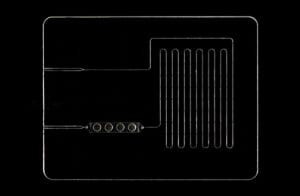Microfluidics is an evolving technology that enables scientists and engineers to perform molecular biology including DNA and RNA sequencing, PCR, and even whole transcriptome analysis more rapidly and at a lower cost than conventional technologies. Microfluidics technology leverages the manufacturing processes previously used for the manufacturing of semiconductor chips to achieve the production, at high volumes of highly engineered devices capable of performing the chemical and biological reactions, separations, and purification operations required for molecular biology projects. By miniaturizing these complex operations, experiments normally conducted at liter scale, can can be performed at a microliter scale or less….a reduction in volume by 6 times!
Benefits of Miniaturization
Miniaturization clearly reduces volumes of costly reagents, but it also enables for designs that eliminate the performance limitations of conventional equipment such as shake flasks and microtiter wells. A good example of this is the standard PCR process for DNA replication which entails performing a series of reaction, heating, cooling, and mixing operations. Because of equipment size and characteristic mixing lengths on the order of centimeters; heating and cooling operations limit the throughput. On the other hand, microfluidics with characteristic mixing lengths on the order of micrometers reduce heating and cooling times to seconds from minutes, which results in a higher throughput for the microfluidic device over the shake flask.
Microfluidics and Flexibility
Another aspect of microfluidic devices is their flexibility. Incredibly, using only a few fundamental geometric shapes (i.e. pillars, channels, holes, and wells) either in combination or individually, it is possible for Citrogene to design a wide variety of custom reaction, separation, and purification operations. This flexibility makes microfluidics a unique technology amenable to both synthetic and modular design strategies.
Custom Designed Microfluidic Devices
Microfluidics allows for once large scale experiments requiring high volume, space, and time to be performed at a much smaller scale. Because of the aforementioned flexibility of the products, Microfluidic devices are fully customizable to fit specific needs. Custom microfluidic designs can be easily made during prototyping to achieve process objectives such as throughput and purity. Production of microfluidic devices can leverage economies of scale by integrating high-throughput replication and bonding technologies.

